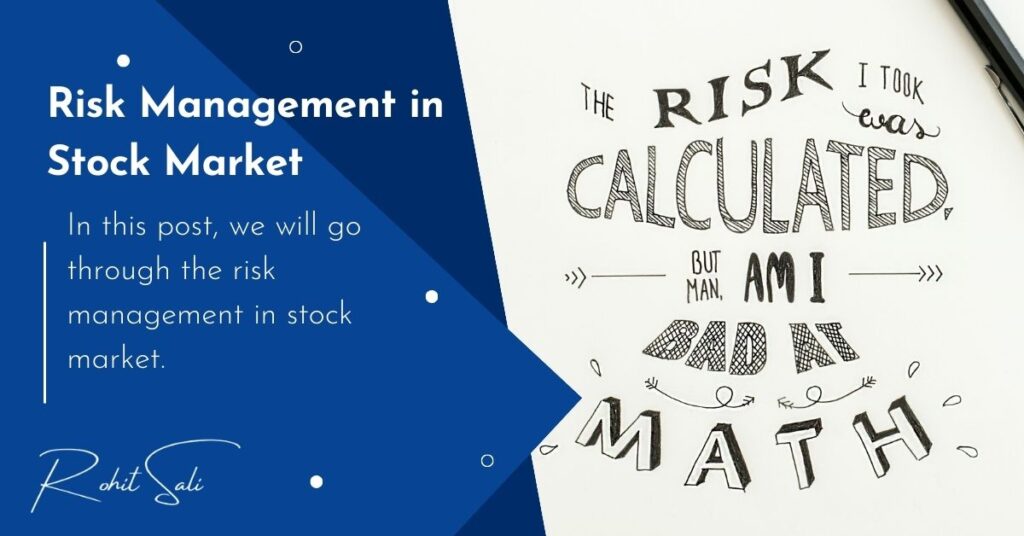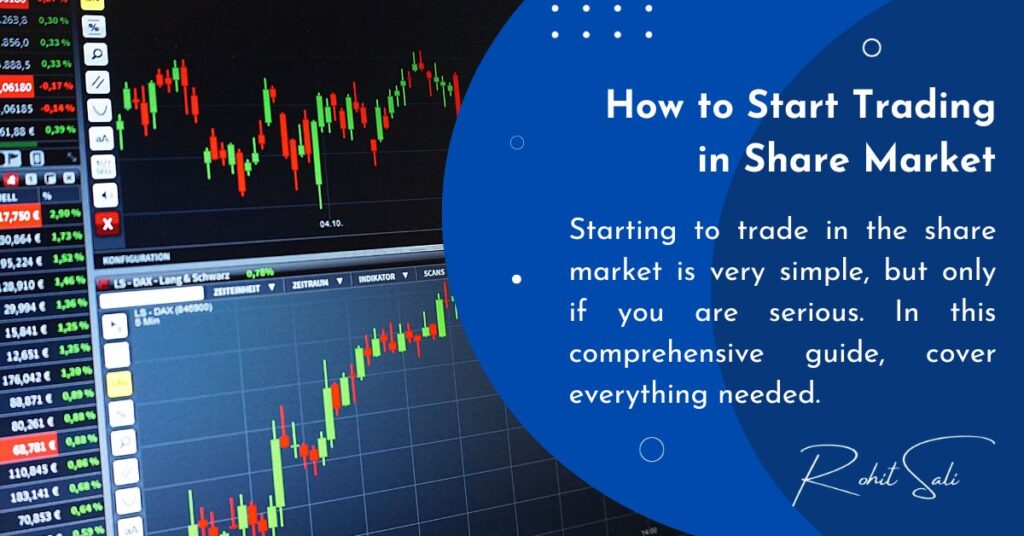Have you ever felt the rush of excitement and trepidation that accompanies the world of stock trading? The stock market, with its ever-fluctuating fortunes, has a magnetic pull that attracts investors and traders from all walks of life.
However, beneath the glitz and glamour, there’s an inherent danger — the risk of losing your hard-earned money. So, how can you navigate this thrilling yet treacherous terrain and emerge as a successful investor?
The answer lies in mastering the art of risk management.
The stock market, often described as a financial battleground, is where investors seek to grow their wealth by buying and selling shares of companies.
It’s a place where fortunes can be made or lost in the blink of an eye, making it a captivating arena for those with a keen interest in finance. The allure of potential profits, coupled with the fear of losses, makes the stock market a captivating and challenging domain.
But, as the saying goes, “With great power comes great responsibility.” In the context of the stock market, this responsibility translates to the crucial task of risk management. Successful investors understand that risk is an inherent part of the game, and it’s not about eliminating it entirely but about managing and mitigating it.
In this article, we’re going to dive into the details of how to protect your money when you’re dealing with stocks. We’ll explore different ways, like strategies and tools, to make sure you don’t lose your investments and can succeed in the world of finance.
Understanding Stock Market Risk
Different types of risks in the stock market
There are various kinds of risks in the stock market, each with its own characteristics and impact on your investments. Here are the main types:
- Market Risk:
- This is the risk associated with the overall market’s movements. When the entire market goes up or down, your investments can be affected. It’s sometimes called systematic risk or beta risk.
- Systematic Risk:
- This risk is connected to the broader economic and market factors that can affect all stocks. Events like economic downturns, interest rate changes, or political instability can lead to systematic risk.
- Unsystematic Risk:
- Also known as specific or company-specific risk, this is the risk that is unique to a particular company or industry. It can be caused by factors like management decisions, competitive pressures, or product failures. Diversification can help reduce unsystematic risk.
- Liquidity Risk:
- This risk is about how easily you can buy or sell an asset without causing a significant price change. Stocks that are less traded may have higher liquidity risk because it can be harder to sell them quickly at a reasonable price.
- Credit Risk:
- This is the risk associated with the financial stability of a company or entity. If you’re holding stocks of a company that has a high level of debt and is struggling to meet its obligations, your investment is at risk.
- Interest Rate Risk:
- Interest rate changes can impact the value of stocks. When interest rates rise, the value of existing bonds and stocks may fall. Companies with significant debt are particularly sensitive to interest rate fluctuations.
- Currency Risk:
- If you invest in international stocks or assets, changes in exchange rates can affect your returns. A strong or weak local currency can make a difference in the value of your investments.
- Political and Regulatory Risk:
- Changes in government policies, regulations, or political instability in a country can affect the stock market. Investors need to be aware of these risks, especially when investing in foreign markets.
- Event Risk:
- These are risks associated with unexpected events, such as natural disasters, terrorist attacks, or sudden company scandals. These events can lead to rapid and unpredictable changes in stock prices.
Understanding these various types of risks is essential for effective risk management in the stock market. By being aware of these risks and implementing strategies to mitigate them, investors can make more informed decisions and protect their investments.
Volatility and its impact on investments
Volatility refers to the degree of price fluctuations in the stock market. High volatility means prices swing dramatically, while low volatility implies steadier, more predictable movements. For investors, the impact of volatility is significant. High volatility can present both opportunities and risks, allowing for potential quick gains but also increasing the likelihood of sudden losses. Low volatility, on the other hand, may offer stability but might limit profit potential. Understanding and managing volatility is crucial for making informed investment decisions.
Importance of Risk Management
The Consequences of Neglecting Risk Management
Neglecting risk management in the stock market can have dire consequences. Without a well-thought-out strategy to mitigate risks, investors are exposed to the unpredictable whims of the market. This can lead to significant financial losses, stress, and, in extreme cases, financial ruin. A lack of risk management can result in impulsive decisions driven by fear or greed, causing investors to buy high and sell low, the exact opposite of a successful investment strategy.
How Effective Risk Management Can Lead to Long-Term Success
On the flip side, effective risk management is the cornerstone of long-term success in the stock market. It empowers investors to make informed, rational decisions, protecting their investments during market downturns and downturns. By diversifying their portfolios, setting stop-loss orders, and carefully assessing risk tolerance, investors can weather market storms and position themselves for growth over time. Risk management not only safeguards your capital but also provides the peace of mind and confidence needed to stay the course, enabling your investments to flourish in the long run.
Key Strategies for Stock Market Risk Management
Diversification and Its Benefits
Diversification involves spreading your investments across different assets or asset classes to reduce risk. By not putting all your eggs in one basket, you can minimize the impact of a poor-performing investment on your overall portfolio. Diversification can include a mix of stocks, bonds, real estate, and other assets, as well as investments in various industries and geographical regions. The key benefit is that it helps balance risk and potential returns, enhancing the stability of your investments.
Setting Stop-Loss Orders and Their Significance
Stop-loss orders are a valuable tool for limiting losses. By setting a predetermined price at which you’ll sell a stock, you protect yourself from excessive losses when a stock’s value is declining. This strategy helps investors maintain discipline, avoid impulsive decisions, and control the level of risk they’re willing to take. Setting stop-loss orders can be a critical component of your risk management strategy, ensuring you don’t ride a declining stock down to substantial losses.
Portfolio Allocation and Risk Tolerance
Portfolio allocation is the art of distributing your investments in a way that matches your risk tolerance. Your risk tolerance is a measure of how comfortable you are with the possibility of losing money in exchange for the potential for higher returns. By aligning your investments with your risk tolerance, you can balance the pursuit of profits with your capacity to withstand market fluctuations. A well-allocated portfolio takes into account your financial goals, time horizon, and willingness to accept risk.
The Role of Research and Analysis in Decision-Making
Effective risk management in the stock market relies heavily on thorough research and analysis. Investors must scrutinize the financial health and prospects of companies they invest in. Fundamental analysis assesses a company’s financials, management, and competitive position, while technical analysis examines historical price and trading data. The information gathered from research and analysis is crucial for making informed investment decisions and managing risk. It enables investors to identify undervalued stocks and avoid potentially risky assets, contributing to a more robust risk management strategy.
These key strategies for stock market risk management, when applied together, form a solid foundation for protecting your investments while seeking to achieve your financial goals in a volatile market.
Tools and Techniques for Risk Assessment
Risk assessment is a critical component of effective stock market risk management. Utilizing various tools and techniques helps investors make more informed decisions and navigate the complexities of the market. Here are some essential tools and techniques:
Volatility Indicators (Beta, Standard Deviation, etc.)
These indicators measure the degree of price fluctuations in stocks or the overall market. Beta indicates a stock’s sensitivity to market movements, while standard deviation measures the historical volatility of a stock’s returns. High values indicate higher risk, and understanding these indicators can guide portfolio diversification and risk mitigation.
Fundamental Analysis
This involves evaluating a company’s financial health, management quality, competitive position, and growth prospects. By scrutinizing financial statements, earnings reports, and economic factors, investors can assess the intrinsic value of a stock. Fundamental analysis provides valuable insights into a stock’s long-term potential and helps identify undervalued or overvalued assets.
Technical Analysis
Technical analysis examines historical price and trading volume data to forecast future price movements. It uses charts, patterns, and various technical indicators to identify trends and potential entry or exit points. While not focused on the fundamentals of a company, technical analysis can be a valuable tool for short-term traders looking to manage risk and make informed decisions based on historical price patterns.
The Use of Financial Ratios
Financial ratios, such as price-to-earnings (P/E) ratio, debt-to-equity ratio, and return on equity (ROE), offer insights into a company’s financial stability, profitability, and efficiency. These ratios are essential for assessing a company’s risk profile and understanding its financial position relative to industry peers. Investors can use these ratios to gauge the level of risk associated with a specific stock or industry.
By incorporating these tools and techniques into your investment strategy, you can effectively assess and manage risks in the stock market. Whether you’re a long-term investor or a short-term trader, having a robust risk assessment toolkit is essential for making well-informed decisions and protecting your investments.
Risk Management Instruments
Effective risk management in the stock market often involves the use of various financial instruments that can help protect investments and limit potential losses. Here, we explore some key instruments that play a vital role in risk management:
Introduction to Hedging and Derivatives (Options, Futures, etc.)
Hedging is a strategy used to offset potential losses in one investment by taking an opposite position in another. Derivatives, such as options and futures, are commonly used for hedging. For example, investors may buy put options to protect against a decline in the value of their stock holdings. Futures contracts allow for the locking in of future prices to mitigate price fluctuations.
How to Use Options for Downside Protection
Options are versatile financial instruments that can be employed to protect investments from downside risk. Put options, in particular, provide a way to set a predetermined selling price for a stock. If the stock’s value falls below this price, the option can be exercised, limiting the loss. This strategy is known as “protective put” and can provide peace of mind to investors concerned about potential downturns in the market.
Understanding risk management instruments and how to utilize them effectively can be a valuable addition to your stock market toolkit. By employing these instruments strategically, investors can proactively manage risk and preserve capital in the face of market volatility and uncertainties.
Psychological Aspects of Risk Management
Investing in the stock market is not merely about numbers and data; it also involves managing your emotions and maintaining discipline in the face of uncertainty. In this section, we’ll delve into the psychological aspects of risk management:
Emotions and Their Impact on Decision-Making
Emotions, such as fear and greed, can significantly influence investment decisions. Fear may lead to panic selling during market downturns, while greed can drive investors to take on excessive risks. Understanding the emotional triggers that affect your decision-making is the first step toward managing risk effectively.
Strategies to Control Fear and Greed
To mitigate the impact of emotions, it’s essential to establish a well-defined investment strategy and adhere to it. This includes setting clear entry and exit points, diversifying your portfolio, and utilizing stop-loss orders. Additionally, practicing mindfulness, maintaining a long-term perspective, and avoiding impulsive reactions to market fluctuations can help control fear and greed.
Emotions in your investment decisions and implementing strategies to manage them, you can bolster your risk management approach. Mastering the psychological aspects of risk management is key to making rational and calculated choices, even in the face of market volatility.
Risk Management Tips for Different Investment Styles
Each investment style – day trading, swing trading, and long-term investing – comes with its own set of risk management considerations. Here are specific risk management tips tailored to each style:
For Day Traders
- Set Strict Stop-Loss Orders: Intraday price movements can be rapid. Set tight stop-loss orders to limit potential losses.
- Use Position Sizing: Allocate a small portion of your capital to each trade to spread risk and avoid significant losses on a single trade.
- Stay Informed: Constantly monitor news and market developments. Be ready to exit positions if unexpected news affects the stock.
For Swing Traders
- Plan Entry and Exit Points: Define clear entry and exit points before entering a trade. This reduces the likelihood of emotional decisions during the trade.
- Risk-Reward Ratio: Maintain a favorable risk-reward ratio for each trade, ensuring that potential gains outweigh potential losses.
- Diversify: Spread your trades across different assets and industries to reduce unsystematic risk.
For Long-Term Investors
- Diversify Your Portfolio: Invest in a mix of asset classes (stocks, bonds, real estate) to minimize market risk.
- Consider Dollar-Cost Averaging: Invest a fixed amount regularly rather than all at once. This helps reduce the impact of market volatility on your investments.
- Focus on Fundamentals: Research companies thoroughly, looking at financial health, management quality, and long-term growth prospects. This approach reduces the risk of investing in poorly performing stocks.
- Rebalance Periodically: Review and rebalance your portfolio annually to ensure it aligns with your long-term goals and risk tolerance.
Adapting your risk management approach to your specific investment style is crucial for preserving capital and achieving your financial objectives. Each style has its unique characteristics and risks, and tailoring your strategy accordingly enhances the likelihood of success in the stock market.
Preparing for Market Crashes
In uncertain times, preparing for market crashes is vital. Here’s what you need to know:
- The Importance of a Well-Defined Exit Strategy: An exit strategy helps protect your investments during market downturns. Knowing when to cut losses or take profits is key to mitigating risks.
- Historical Lessons from Market Crashes: History provides valuable insights. Studying past market crashes reveals patterns, mistakes to avoid, and strategies that can help safeguard your investments in turbulent times.
By being proactive and learning from history, you can better navigate market crashes and secure your financial future.
Wrap Up
In closing, risk management in the stock market is a paramount aspect of successful investing. Here are the key takeaways to remember:
- Risk management is essential because it allows investors to protect their investments in the face of market uncertainties.
- Understanding and diversifying different types of risk, including market, systematic, and unsystematic risks, is fundamental.
- Strategies like diversification, setting stop-loss orders, aligning portfolio allocation with risk tolerance, and conducting thorough research are pivotal in minimizing risk.
Yet, it’s crucial to emphasize the importance of ongoing education and adaptability in a dynamic market:
- Markets are ever-evolving, and new risks and opportunities continually emerge. Staying informed and up-to-date is vital.
- Embrace adaptability and be ready to adjust your risk management strategies as market conditions change.
- Continuous learning and an open-minded approach are essential for long-term success in the stock market.
By adhering to these principles and maintaining a diligent, adaptable, and informed approach to risk management, investors can navigate the often turbulent waters of the stock market with confidence and increase their chances of achieving their financial goals.




